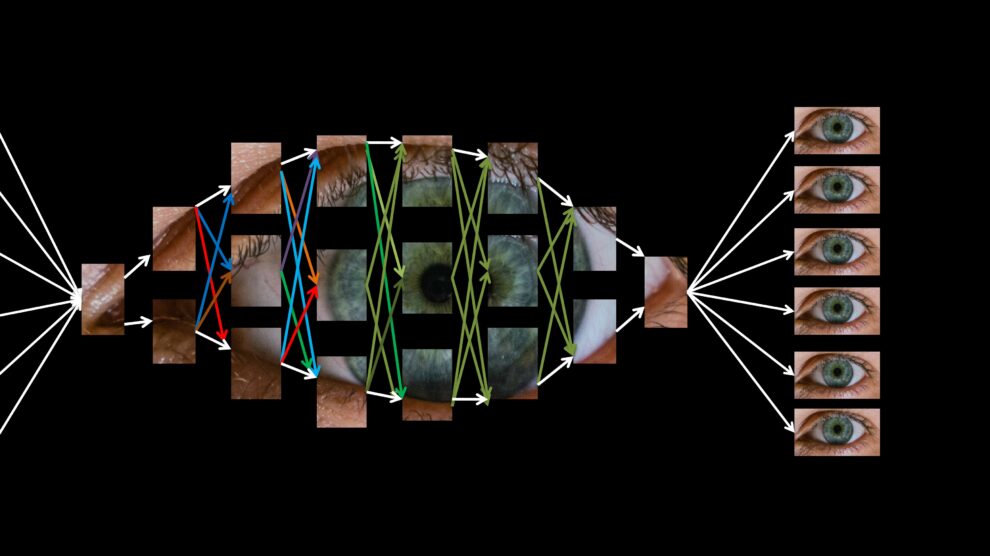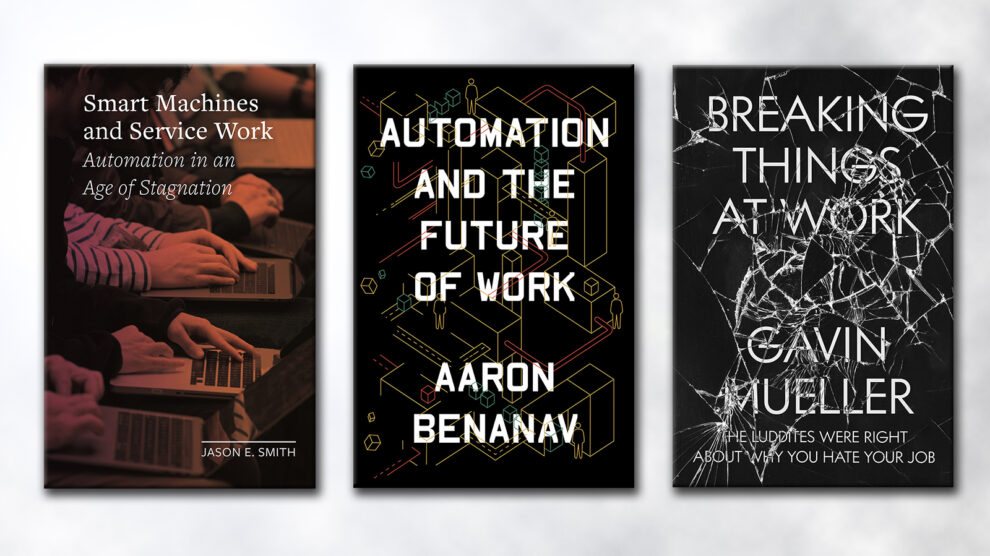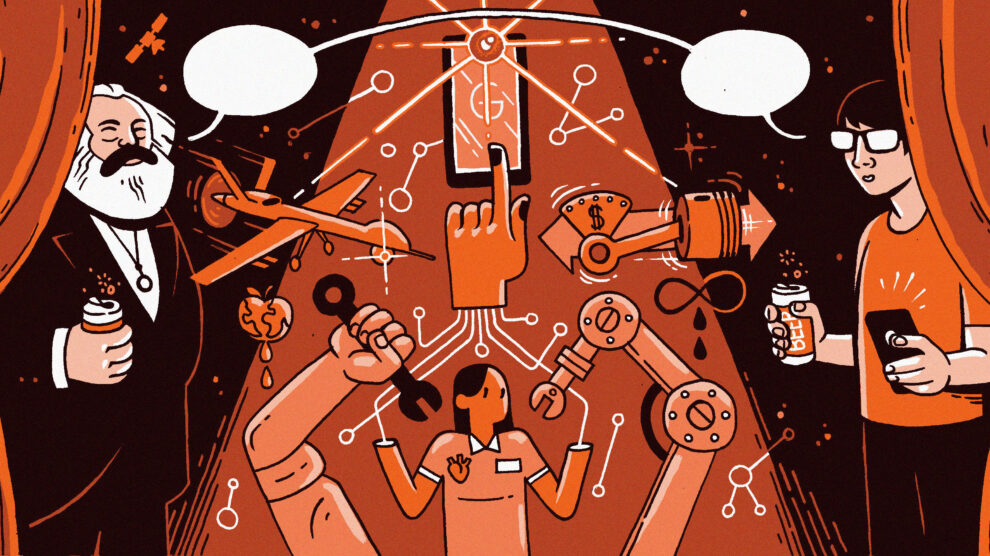October 7, 2021
From Scientists to Salesmen
A Review of Noah Hutton’s In Silico
By Jennifer Lee
This article is an online-only complementary piece of Do No Evil: An Interview with Noah Hutton.

Noah Hutton’s independent documentary In Silico is a captivating, decade-long account of the rise and fall of Henry Markram’s controversial Human Brain Project (HBP).1 The HBP began in 2013 as an ambitious, ten-year-long, billion-euro program that aimed to build an exact digital simulation of the human brain. It promised to help elucidate the mechanisms that underlie information processing, from molecular processes to large-scale neural networks. As the years go by, the chasm between the HBP’s promised and delivered product is revealed to be so astounding that, despite its respectful and factual reporting, the film can’t help but elicit a cynical laugh or two at the project’s expense. At its most extreme, the project is evocative of Fyre festival in scale, hype, and misguided ambition—and of course, in the raw schadenfreude its failures evoke in critics.2
On the face of it, the documentary is simply a cautionary tale about the dangers of salesmanship and hype in science, a rebuke of “Big Science” and an implicit endorsement of the humbler “status quo” science championed by Markram’s many critics. A review in Nature pins it as “a fascinating window into the trouble grandiose research projects and grandiose personalities can generate.”3 But those who stop at the “big science, big personalities” story risk missing the forest for the trees. For all the HBP’s talk of revolutionizing neuroscience, In Silico’s documentation of the HBP serves as a remarkable picture of business-as-usual in laboratories of all subjects and sizes. Seen as a social phenomenon, the HBP marks no fundamental departure from the logic of the corporatized research model that pervades academic STEM, including the labs of even its most vocal critics. Instead, the project’s spectacular size and public profile serve as a magnifying lens held to the system at large, allowing us to examine the rot of corporate bureaucracy taking hold of scientific research institutes everywhere.
As the film follows Markram’s transformation from scientist to salesman, we’re reminded of the parallel transformation occuring on an institutional scale all around us. Viewed this way, the film is a stunning reminder that a kind of neoliberal logic has worked for decades to make the culture, language, organization, and aims of academic research institutions virtually indistinguishable from those of capitalist firms4 —and the increasingly corporatized government bureaucracies that enable them—much to the detriment of everyday people and the practice of science itself.
Courting Capital
As a fellow neuroscientist and a friend to Henry Markram, Christof Koch remarks that Markram had developed two faces fairly early on in the game: that of the thoughtful scientist and that of the Messiah-like figure he embodied when speaking to public funders.
It’s a characterization that ought to resonate with scientists everywhere. Students are routinely encouraged to develop an aptly named “elevator pitch” of their work—not so much to candidly communicate their research, and its challenges, short-comings, and potentialities to “everyday people,” but to cultivate the kind of self-promotional spiel that will be necessary to compete for jobs and funding down the road. In a nod to management consultancy firms like Deloitte or McKinsey, these exercises in pitching, marketing, and building one’s personal brand coincidentally serve as initiation rites for the induction of precarious student workers into the professional-managerial class.5
It’s not until years later—as we see Markram abandoning his 10 year timeline for a 30-year one, poring over the wording of yet another marketing pitch, and fussing over the storyboard for the HBP’s umpteenth promotional video—that it clicks for the viewer: somewhere along the way, cultivating the perfect promotional program had become almost an end in itself for Markram, with genuine scientific inquiry relegated to something of an afterthought.
Spinning Our Wheels, and Going Nowhere
In “Of Flying Cars and the Declining Rate of Profit,”6 late anthropologist David Graeber asks why it is that the great scientific advances we all dreamed of as kids (flying cars, anti-gravity shoes, teleportation guns, robots that fold our laundry) haven’t yet materialized, despite showerings of funding upon these fields from federal military agencies like Defense Advanced Research Projects Agency (DARPA), and in spite of the exponentially growing number of scientific papers published every year.7 He argues that a powerful but overlooked reason for this is that scientific research—in all its potential for playfulness and creativity—has fallen prey to the stultifying effects of a culture of corporate bureaucracy.
Nowhere is this disappointment more profound and more obvious than in the immensely well-funded field of neuroscience, now two decades on from what Bush Sr. prematurely declared to be the “Decade of the Brain.”8 Money is certainly being thrown at basic neuroscience research by both Democrats and Republicans alike, and, if the field’s feverish rate of publication is any indication,9 the wheels of academic research certainly are spinning. Meanwhile, we still know next to nothing about how the brain works. Moreover, though they exist, examples of emancipatory neural technologies that empower everyday people are hard to find. Instead, tepid advances in neuroscience in the coming decade will likely resemble “quick, marketable wins” in the areas of neural wearables, brain-computer interfaces,10 and “neuroeconomics” (which can be credited for policymakers’ obsession with behavioural “nudging”).11 All are sub-disciplines funded primarily for their utility in consumer advertising and labor surveillance, providing the potential to both predict and control behaviour at the physiological level.
Corporate Science, Big and Small
In an interview for the film, neuroscientist Zach Mainen suggests that the flawed philosophical premises of the HBP meant it was doomed from the outset. By contrast, he claims that our status quo system of small, boutique labs, each with their own set of philosophical leanings, provide a safeguard for making stable progress in neuroscience. Each lab brings a competing conceptual approach to the study of the brain, and the best approach or theory is expected to win out.
As Graeber notes, this competitive marketplace-of-ideas intuition, coupled with America’s obsession with the “mythic origins of Silicon Valley,” leads us to imagine that scientific progress is best accomplished by modestly sized research groups resembling “small teams of plucky entrepreneurs”—teams that take risks, compete, and fail fast.
Diverse, inclusive thought is undoubtedly a boon to (and necessary for) making progress in neuroscience. The reality, however, is that small labs are hardly spared from the same corporate pressures that afflicted the HBP—they too must abide by the system of social credit that directs research programs everywhere.
Pervasive corporate managerialism has made it such that the number and prestige of publications in prestigious for-profit journals has become the key metric of one’s value, and the critical currency through which stable, managerial-class jobs are procured. Meanwhile, the deliberate ballooning of for-profit student programs in STEM, coupled to an ever-shrinking job market,12 keep the labor pool highly skilled, oversaturated, and ever more desperate to compete. Taken together, these conditions have helped precipitate a euphemistically named “replication crisis” that, seen as the natural outcome of competitive social credit-seeking behaviors within a corporate system,13 is less a crisis of statistical power than it is a crisis of social disempowerment: negative results, however truthful, simply do not sell.
In Silico is a salient reminder that truly revolutionary science will require reversing the spread of neoliberal logic in our own institutions, big or small.
In a system where one’s publication count has real, material consequences for disempowered workers, “salami publishing” has also become all but the default in many fields.14 Scientists tread water by spending their time slicing the same result, theory, or methodology into as many thin, redundant publications as possible for the express purpose of racking up their numbers. Otherwise, scientists are incentivized to produce novel results by creating deeply derivative, combinatorial iterations of others’ work, picking at what low-hanging fruit still remains.
Academic research, then, far from being a bastion of creative, eclectic, and impractical thinkers, has instead come to select for those individuals who are highly adept at what the system rewards best—selling things, promoting themselves, and racking up paper publications as ends in themselves. The HBP itself produced over 1400 scientific publications and governance documents galore.15 Decades of bureaucratized science has culminated in, quite literally, a generation of self-promoters and paper-pushers, with Henry Markram merely serving as a particularly salient case study within the public eye.
Resisting From Within
Beyond the schadenfreude and petty indignation In Silico will elicit in other elite scientists, the movie captures a phenomenon of corporatized science that affects the HBP and its many critics alike. In tackling everything from climate change, to the next pandemic, to the mysteries of the brain, emancipatory science will require big science, little science, and science of all sizes in between. The size and scale of the science really isn’t what’s at issue—it matters much more why and for whom the science is being done. Much like the unlucky staffers that worked day and night to realize the grueling, and ultimately vacuous, technical feats of the HBP, an increasingly managerial, elitist, and undemocratic scientific process will keep us spinning our wheels while leading us nowhere in particular. Worse yet, our current systems seem to be leading us for the most part down the path of Neuralink wearables, high-tech neuro-marketing, behavioral nudge theory, and other tools that merely serve to further labor discipline and social control.
In Silico is a salient reminder that truly revolutionary science will require reversing the spread of neoliberal logic in our own institutions, big or small. From the lab technicians working tirelessly to produce COVID-19 vaccines to the computer scientists at the Human Brain Project, scientists and communities are being cheated out of their right to determine how and for whom research is conducted.But they can fight back, collectively, by imagining and creating social and economic systems that will provide them the freedom to play, fail, and imagine the world otherwise.
In line with the themes explored in Noah Hutton’s second film Lapsis, building real, grassroots unions for STEM students and researchers is one step we can take together. Unionizing STEM workers ensures subordinate scientists (including research assistants, lab technicians, graduate students, and post-doctoral researchers) understand themselves as the essential workers that form the backbone of scientific institutions, without whom laboratories simply cannot function. Many professors and administrators have worked to infantilize graduate workers, labelling them as students rather than workers,16 not worthy of a union—their trainees are taught to consider themselves privileged to be able to work in science at all, and are kept desperate to compete so that they may one day take their place.
Building solidarity is particularly challenging when early-career scientists are meant to uproot their lives and relationships every few years in search of a stable job. However, if such a movement were to succeed, scientists might one day work and play in the service of local struggles, grounded in the specifics of their community, culture, and bioregion. Rather than pandering to faceless, centralized funding authorities, jet-setting scientists could one day work out of personal care for, and accountability to, the needs of the local communities in which they make their lives.
In Silico reminds us that revolutionary science will require that we resist a culture of corporate hierarchy and individualized self-promotion within labs, build solidarity through collective organizing, and stand up for a scientific process that is honest, creative, inclusive, and community-led—a science that is, at times, deeply self-effacing. Otherwise put, revolutionary science means fighting back against the logic of senseless competition that has made salesmen of us all.
—
Jennifer Lee is a graduate student in neuroscience. She lives and works in Tiohtià:ke/Montréal, Québec, on the unceded territory of the Kanien’kehá:ka.
Notes
- “Human Brain Project,” Human Brain Project, accessed September 22, 2021, https://www.humanbrainproject.eu/en/.
- Meagan Day, “Friendly Fyre,” Jacobin, May 2, 2019, https://www.jacobinmag.com/2019/02/fyre-festival-documentary-review-capitalism.
- Alison Abbott, “Documentary Follows Implosion Of Billion-Euro Brain Project,” Nature News, December 7, 2020, https://www.nature.com/articles/d41586-020-03462-3.
- Some suggest that managerial governance cannot simply be understood as a manifestation of neoliberal logic, as it comes from a similar but distinct lineage and must be analyzed in its own right. See: Samuel Knafo, Sahil Jai Dutta, Richard Lane, and Steffan Wyn-Jones, “The Managerial Lineages of Neoliberalism,” New Political Economy 24, no. 2 (2019): 235–251.
- Barbara Ehrenreich and John Ehrenreich, “The Professional-Managerial Class,” Between Labor and Capital 5 (1979): 45.
- David Graeber, “Of Flying Cars and the Declining Rate of Profit,” The Baffler 19 (2012): 66–84.
- Lutz Bornmann and Rüdiger Mutz, “Growth Rates of Modern Science: A Bibliometric Analysis Based on the Number of Publications and Cited References,” Journal of the Association for Information Science and Technology 66, no. 11 (2015): 2215–22.
- Murray Goldstein, “Decade of the Brain: An Agenda for the Nineties,” Western Journal of Medicine 161, no. 3 (1994): 239.
- Andy Wai Kan Yeung, Tazuko K. Goto, and W. Keung Leung, “The Changing Landscape of Neuroscience Research, 2006–2015: A Bibliometric Study,” Frontiers in Neuroscience 11 (2017): 120.
- “Are You Ready for Tech That Connects to Your Brain?” Harvard Business Review, September 28, 2020, https://hbr.org/2020/09/are-you-ready-for-tech-that-connects-to-your-brain.
- Bloomberg Cities, “Explainer: What Is a Behavioral ‘Nudge’?” Medium, February 28, 2020, https://bloombergcities.medium.com/explainer-what-is-a-behavioral-nudge-f32150149deb.
- Gary Stix, “Where Will All the New Neuroscientists Go?”, Scientific American Blog Network, June 19, 2016. https://blogs.scientificamerican.com/talking-back/where-will-all-the-new-neuroscientists-go/.
- Marta Serra-Garcia and Uri Gneezy, “Nonreplicable Publications Are Cited More Than Replicable Ones,” Science Advances 7, no. 21 (2021): eabd1705; Liam Kofi Bright, “Why Do Scientists Lie?,” Royal Institute of Philosophy Supplements 89 (2021): 117–129.
- Vesna Šupak Smolčić, “Salami Publication: Definitions and Examples,” Biochemia Medica 23, no. 3 (2013): 237–241.
- “HBP Highlights and Achievements,” The Human Brain Project, accessed September 22, 2021, https://www.humanbrainproject.eu/en/science/highlights-and-achievements/#:~:text=HBP%20research%20has%20resulted%20in,we%20highlight%20some%20of%20them; “HBP–Governance.” The Human Brain Project, accessed September 22, 2021, https://www.humanbrainproject.eu/en/about/governance/.
- Marissa Knoll, “Graduate Students Do Real Work. Let Us Unionize,” Salon, December 7, 2019. https://www.salon.com/2019/12/08/graduate-students-do-real-work-let-us-unionize_partner/.





